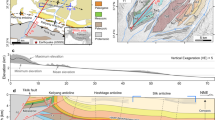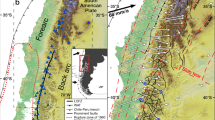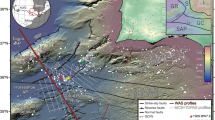Abstract
Collisional mountain belts are characterized by fold and thrust belts that grow through sequential stacking of thrust sheets from the interior (hinterland) to the exterior (foreland) of the mountain belt1,2,3,4,5. Each of these sheets rides on a fault that cuts up through the stratigraphic section on inclined ramps that join a flat basal fault at depth. Although this stair-step or ramp–flat geometry is well known, there is no consensus on why a particular ramp forms where it does. Perturbations in fault shape6,7, stratigraphy8,9, fluid pressure10,11, folding2,12, and surface slope13,14 have all been suggested as possible mechanisms. Here we show that such pre-existing inhomogeneities, though feasible causes, are not required. Our computer simulations show that a broad foreland-dipping plastic strain band forms at the surface near the topographic inflection produced by the previous ramp. This strain band then migrates towards the rigid base, where the plastic strain is preferentially concentrated in a thrust ramp. Subsequent ramps develop toward the foreland in a similar fashion. Syntectonic erosion and deposition may strongly control the location of thrust ramps by enhancing or removing the surface point of initiation.
This is a preview of subscription content, access via your institution
Access options
Subscribe to this journal
Receive 51 print issues and online access
$199.00 per year
only $3.90 per issue
Buy this article
- Purchase on Springer Link
- Instant access to full article PDF
Prices may be subject to local taxes which are calculated during checkout





Similar content being viewed by others
References
Bally, A. W., Gordy, P. L. & Stewart, G. A. Structure, seismic data, and orogenic evolution of the southern Canadian Rocky Mountains. Can. J. Petrol. Geol. 14, 337–381 (1966)
Dahlstrom, C. D. A. Structural geology in the eastern margin of the Canadian Rocky Mountains. Bull. Can. Petrol. Geol. 18, 332–406 (1970)
Armstrong, F. C. & Oriel, S. S. Tectonic development of Idaho-Wyoming thrust belt. Am. Assoc. Petrol. Geol. Bull. 71, 1847–1866 (1965)
Wiltschko, D. V. & Dorr, J. A. Timing and deformation in overthrust belts and foreland of Idaho, Wyoming, and Utah. Am. Assoc. Petrol. Geol. Bull. 67, 1304–1322 (1993)
Jordan, T. E., Allmendinger, R. W., Damanti, J. F. & Drake, R. E. Chronology of motion in a complete thrust belt; the Precordillera, 30-31° S., Andes Mountains. J. Geol. 101, 135–156 (1993)
Wiltschko, D. V. & Eastman, D. B. Role of basement warps and faults in localizing thrust-fault ramps. Geol. Soc. Am. Mem. 158, 177–190 (1982)
Knipe, R. J. Footwall geometry and the rheology of thrust sheets. J. Struct. Geol. 7, 1–10 (1985)
Bombalakis, E. G. Thrust–fault mechanics and origin of a frontal ramp. J. Struct. Geol. 8, 281–290 (1986)
Platt, J. P. The mechanics of frontal imbrication, a first-order analysis. Geologische Rundschau 77, 577–589 (1986)
Davis, D., Suppe, J. & Dahlen, F. A. Mechanics of fold-and-thrust belts and accretionary wedges. J. Geophys. Res. 88, 1153–1172 (1983)
Cello, G. & Nurr, A. Emplacement of foreland thrust systems. Tectonics 7, 261–272 (1988)
Goff, D. F., Wiltschko, D. V. & Fletcher, R. C. Decollement folding as a mechanism for thrust-ramp spacing. J. Geophys. Res. 101, 11341–11352 (1996)
Panian, J. & Pilant, W. L. A possible explanation for foreland thrust propagation. J. Geophys. Res. 86, 8607–8615 (1990)
Goff, D. F. & Wiltschko, D. V. Stresses beneath a ramping thrust sheet. J. Struct. Geol. 14, 437–449 (1992)
Bally, A. W., Burbi, L., Cooper, C. & Ghelardoni, R. Balanced sections and seismic reflection profiles across the central Apennines. Mem. Soc. Geol. It. 35, 257–310 (1986)
Royse, F. Jr, Warner, M. A. & Reese, D. L. Deep Drilling Frontiers of the Central Rocky Mountains 41–54 (Rocky Mountain, Assoc. Geol, 1975)
Suppe, J. A retrodeformable cross section of northern Taiwan. Proc. Geol. Soc. China 23, 46–55 (1980)
Dixon, J. S. Regional structural synthesis, Wyoming salient of western overthrust belt. Am. Assoc. Petrol. Geol. Bull. 66, 1560–1580 (1982)
Price, R. A. & Mountjoy, E. W. Geologic structure of the Canadian Rocky Mountains between Bow and Athabasca rivers—a progress report. Structure of the southern Canadian Cordillera. Geol. Assoc. Can. Spec. Pap. 6, 7–25 (1970)
Hill, K. C. Structure of the Papuan fold belt, Papua New Guinea. Am. Assoc. Petrol. Geol. Bull. 75, 857–872 (1991)
Williams, G. D. Thrust tectonics in the south central Pyrenees. J. Struct. Geol. 7, 11–17 (1985)
Kraig, D. H., Wiltschko, D. V. & Spang, J. H. Interaction of basement uplift and thin skinned-thrusting, Moxa arch and the Western Overthrust Belt, Wyoming: A hypothesis. Am. Assoc. Petrol. Geol. Bull. 99, 654–662 (1987)
Elliot, D. The motion of thrust sheets. J. Geophys. Res. 81, 949–963 (1976)
Chapple, W. M. Mechanics of thin-skinned fold-and-thrust belts. Geol. Soc. Am. Bull. 89, 1189–1198 (1978)
Makel, G. & Walters, J. Finite-element analysis of thrust tectonics: computer simulation of detachment phase and development of thrust faults. Tectonophysics 226, 167–185 (1993)
Mandl, G. & Shippam, G. K. Mechanical model of thrust sheet gliding and imbrication. In Thrust and Nappe Tectonics 79–98 (Geol. Soc. Lond. Spec. Publ., 1981)
Davies, R. K. & Fletcher, R. C. Shear bands in a plastic layer at yield under combined shortening and shear: A model for the fault array in a duplex. In Deformation Mechanisms, Rheology and Tectonics, 123–131 (Geol. Soc. Lond. Spec. Publ. 54, 1990)
Hibbitt, H. D., Karlson, B. I. & Sorenson, E. P. ABAQUS Theory Manual (Hibbitt, Karlson & Sorenson, Pawtucket, RI, 1997)
Handin, J. & Hager, R. V. Experimental deformation of sedimentary rocks under confining pressure: Tests at room temperature on dry samples. Am. Assoc. Petrol. Geol. Bull. 41, 1–50 (1957)
Malvern, L. E. Introduction to the Mechanics of a Continuous Media (Prentice-Hall, Englewood Cliffs, NJ, 1969)
Acknowledgements
The NSF Tectonics programme supported this work. We wish to thank B. Johnson and J. Melosh for discussions.
Author information
Authors and Affiliations
Corresponding author
Ethics declarations
Competing interests
The authors declare that they have no competing financial interests.
Rights and permissions
About this article
Cite this article
Panian, J., Wiltschko, D. Ramp initiation in a thrust wedge. Nature 427, 624–627 (2004). https://doi.org/10.1038/nature02334
Received:
Accepted:
Issue Date:
DOI: https://doi.org/10.1038/nature02334
This article is cited by
-
Varying frontal thrust spacing in mono-vergent wedges: An insight from analogue models
Journal of Earth System Science (2013)
Comments
By submitting a comment you agree to abide by our Terms and Community Guidelines. If you find something abusive or that does not comply with our terms or guidelines please flag it as inappropriate.



